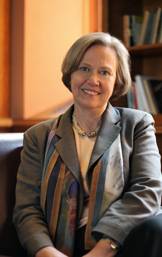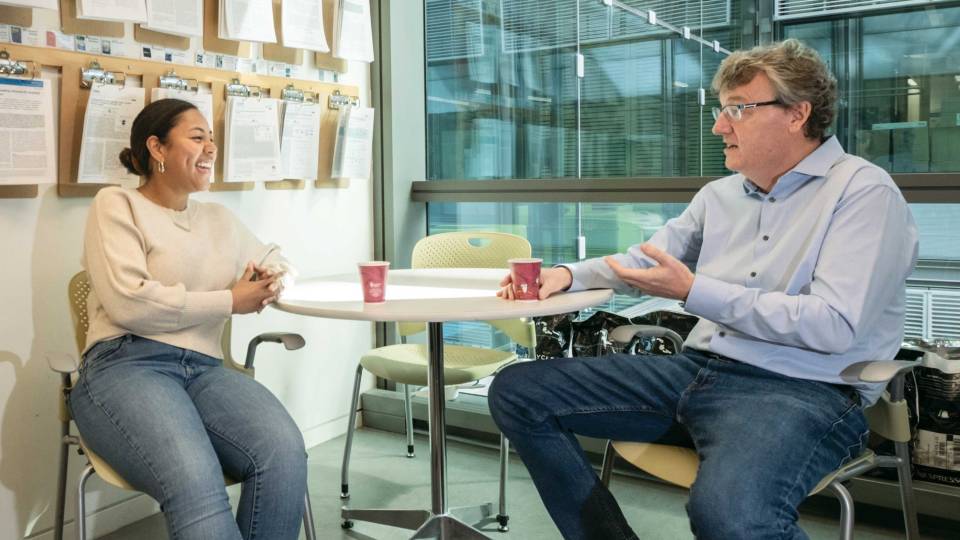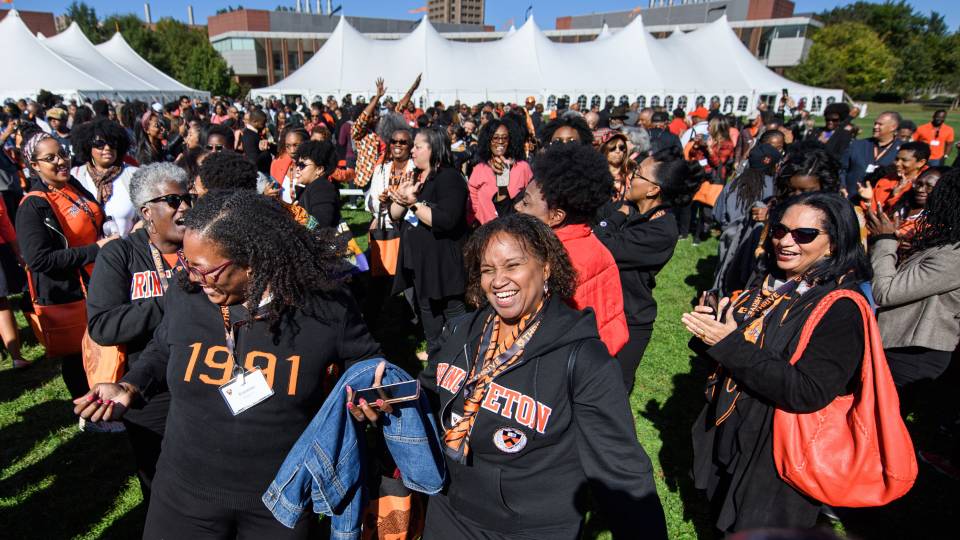From the Sept. 25, 2006, Princeton Weekly Bulletin
During her first year as Princeton’s president, Shirley M. Tilghman was constantly asked to detail her vision for the University. Her answer was always at the ready: “Ask me later.”
Tilghman set out to identify areas where the University needed to make progress and could enhance its time-honored strengths in teaching and research. Five years later, her vision has taken shape.
Tilghman is overseeing a number of major advances, including an 11 percent increase in the undergraduate student body by 2012, the introduction of a four-year residential college system in 2007 and the planning and building of new facilities for engineering, neuroscience, chemistry and the arts. She also has led efforts ranging from strengthening key academic disciplines and increasing students’ social options to improving health and well-being resources and making the University a more diverse and family-friendly workplace.
A renowned molecular biologist and award-winning teacher, Tilghman served on Princeton’s faculty for 15 years before moving to Nassau Hall. In the following interview, she addresses the progress of significant initiatives undertaken by her administration as well as key issues facing the University and her goals for Princeton over the next several years. Tilghman also discusses her experiences — both professional and personal — since being installed as the University’s 19th president in September 2001.
What do you consider the most significant changes at Princeton since you became president?I think from the perspective of the University it is the creation of the four-year college system, which was conceived before I became president but needed flesh on the bones. We have been putting flesh on those bones for the last five years, including the building of Whitman College, which is going to be a simply stunning addition to the campus. That has been the single most important issue that we have tackled in the last five years.
What are the advantages of revamping the residential college system?
The big advantage is the creation of more options for students, so that
students will have different ways of experiencing their junior and senior years
than the two options that are currently available to them.
We had heard pretty consistently over the years that you could roughly
divide the undergraduate student body into quadrants: 25 percent were deeply
satisfied with the choice they made as a junior and senior, whether it was to
join an eating club or to become independent; 25 percent were deeply unhappy
with their options; and 50 percent — the two middle quadrants — were someplace
in between those extremes. To have such a significant percentage of the student
body polarized in that way seemed unacceptable to us.
When we conceived of a four-year college, it was an extraordinary
opportunity to think of the college as more than a place where people sleep and
eat, but as a place that is an integral part of the educational milieu of the
University. We want to create a community in these colleges that represents
everyone — from the master and visiting faculty (there will be apartments for
visiting faculty in the colleges); to graduate students, who will see the
college both as their home and a place where they are actually participating in
the life of the college; to the undergraduates.
What else would you cite as important changes since taking office?
For me, one of the great satisfactions — and this is more personal than
anything else — has been building a really stellar team of senior
administrators. I’m very proud of that team — I think it’s an extremely strong
and capable team that works well together. Because so many senior members of
the administration retired at the time that Harold Shapiro retired, it was a
major undertaking to replace that team. It makes coming to work a pleasure,
knowing that I’m working with these individuals.
Looking ahead to the next five years, what have you identified as the
University’s major priorities?
The priorities looking ahead are now firmly in place.
First, we are focused on fulfilling the goals of the strategic plan of the
engineering school, which has a very fine dean now in Vince Poor but needs to
be bigger. The school has identified areas where it wants to be pre-eminent,
and we have to hire faculty and attract students in those areas.
In the natural sciences, we are paying particular attention to neuroscience,
which is going to be a major new initiative for us. We are strengthening the
chemistry department and providing it with a modern facility for the first time
in 80 years. And, of course, we want to ensure that what are now our
traditional strengths — such as mathematics and physics — remain strong going
forward.
One of the most exciting new initiatives is the expansion of the creative
and performing arts. That is something I’m thrilled about and will spend a lot
of time working on over the next five years.
We also have been committed to ensuring that our students become
cosmopolitans and citizens of the world — through the creation of the Princeton
Institute for International and Regional Studies, the enhancement of study abroad
opportunities and the enhancement of curricula in the areas of both regional
and international affairs.
Finally, there is a whole category of priorities in campus life outside the
classroom. We have a very strong commitment to health and well-being — everything
from getting your flu shot to making sure you have work-family balance in your
lives. That also extends to things like both recreational and varsity
athletics, ensuring that we have the facilities that our students need in order
to stay healthy and compete effectively. And we want to ensure that students
who want opportunities for community service have bountiful choices.
Another major initiative that is midstream is campus planning. How did you
develop your approach to the planning process?
Some of these initiatives I just mentioned are going to require new
facilities. Before we embarked on a piecemeal expansion of the campus, we
thought it would be very helpful for the University to spend two years thinking
hard about the campus as a whole and how it should grow in a coherent way. We
are one year into the plan, and it has been enormously helpful. We are thinking
much more intelligently and clearly about future expansion than we would be had
we not undertaken this plan. I think it will serve us well probably for about
10 years, and then there will be a need for another plan.
How has the plan evolved? How do you think the campus will look different 10 years from now?
The plan almost from the beginning began to focus on the periphery of the campus. We took a look at the core campus and concluded that it has been built out about as densely as it could be, so there were very few opportunities left to grow the campus from within. That turned our attention to the periphery, where there were two choices: One was to build on our side of the lake, around the edges of the campus, and the other was to jump the lake and start to build on the West Windsor lands, which are empty and extremely enticing if you want to do substantial expansion.
We thought about that question a great deal, even before the campus plan began, and we concluded that right now it would be very hard to link anything on the other side of the lake to the campus and have it feel like a coherent whole. So we’ve decided to focus on the periphery of the campus, and that includes: the Alexander/University Place area, where we imagine the expansion of the creative and performing arts will be; the south end of the campus on Washington Road, where we know chemistry and neuroscience are going to be; and the area around the playing fields up through the E-Quad on the east side of campus, including Ivy Lane, Western Way and the E-Quad itself, where we now have permission to build approximately 180,000 additional square feet. We imagine those are going to be the three areas where any expansion over the next 10 to 20 years will focus.
Are there other academic areas where you see the University committing greater resources?The one area where we are certain to make a fairly substantial investment in the next five years is in African American studies. (See related story.)
Also on the academic front, your administration has worked to curb grade inflation and to encourage more students to concentrate in traditionally smaller departments. How do you view the progress of those efforts?
Both of those have seen real progress, and in some cases faster progress than we anticipated, which is a very good thing. In the case of grade inflation, there certainly were departments, particularly in the natural sciences and some of the social sciences, that already were grading according to the new guidelines and had been for 20 years. Many of the departments that had allowed grades to creep up over the last 20 years saw some downward trends, which I think is very healthy.
In terms of the majors, we’ve seen shifts in concentration that we think are really going to serve our students well, in the sense that departments will have more appropriate numbers of students that they can manage. I’m proud to say molecular biology is now in the top five — this is the first time that a science has been in the top five in some time, so it’s great to see that diversity. There are other departments — religion, for example — that have really increased the number of majors, and we think that’s a terrific trend.
You mentioned the increase in concentrators in molecular biology, which is your own field. What do you think about the prognosis for increasing students’ interest in science more generally? What needs to be done?This is a significant problem. I wouldn’t want to underplay the challenge that not just Princeton, but all of higher education, faces. In my generation, the best and the brightest thought that a career in science would be one of the most exciting things you could do with your life. We’ve seen a decline in that trend in the last 20 years, and I think it’s worrisome for the competitiveness of the country.
The problem, of course, does not begin at universities and colleges — it begins in K-12 education. But we have work to do in the universities as well, because we know there is a net loss of students in both the natural sciences and engineering at Princeton, meaning many more students come in thinking they want to be scientists than graduate thinking they want to be scientists. I think the villains of this piece, if you will, are the introductory courses that often have very large enrollments and are often uninteresting to students who really want to be inspired by modern science and instead find themselves memorizing facts and not understanding the context of those facts.
Two really exciting initiatives here at Princeton are among the best in the whole country. One is the integrated science curriculum in the genomics institute and the other is the new freshman curriculum in engineering. Both are really designed to take students in September of freshman year and introduce them to the fundamentals that they will need to know if they’re going to be good scientists, but introduce them in a way that is engaging and relevant to the really important and interesting questions of the day.

Princeton has succeeded in enhancing the economic diversity of the student
body through improving its financial aid program. But what else can be done to
continue efforts to make Princeton more accessible to the broadest range of
students?
Our biggest challenge at this point is making Princeton known to a broader
array of students all over the country, and particularly not just to know
Princeton’s name and reputation — which I think is broadly known — but to know
that our financial aid makes it possible for virtually every student to come
and matriculate here if they are accepted. If I had a dollar for every time
I’ve been told, “Gee, I never thought about Princeton, I just assumed I
couldn’t afford it,” I would be a rich woman. So we have a lot of work to do to
send the message more broadly that our financial aid is really extraordinary.
How do you address concerns about the rising cost of Princeton tuition, and
of higher education in general, when meeting with prospective students and
parents, alumni and others?
There are a number of things that are important to understand. One is that
tuition as a percentage of our operating budget has been falling for about 20
years, which means we are using a greater percentage of the income of the
endowment to support the operating budget of the University. We’re now at 40
percent, which is the highest in our peer group in terms of dependence on
endowment income. Secondly, as modestly as we raise tuition every year,
financial aid picks up that difference — so students on financial aid are not
being asked to shoulder a greater percentage of the cost. The third point is
that we have purposely tried to have the lowest cost of our peer institutions.
So we’re very sensitive to this issue.
Speaking of sensitive issues, the Robertson family’s lawsuit against
Princeton has required significant use of University resources and has
attracted considerable attention in the press. How would you characterize the
impact of the lawsuit on the University?
I think, blessedly, it has had very little impact on the University and the
Woodrow Wilson School. In Anne-Marie Slaughter we have one of the finest deans
of public policy and international affairs we have ever had at the University
and one of the finest in the country, if not the finest. Despite the lawsuit,
she has been able to accomplish simply extraordinary things with the school,
including: the hiring of a whole new generation of faculty in international
relations; a revitalization of the school as a very visible part of the
national and international public policy debate; and the creation of a whole
new graduate program, Scholars in the Nation’s Service, that is dedicated to
inspiring young men and women to take federal government service seriously. In
quite a remarkable way, the school has absolutely flourished during these four
years that the litigation has been under way.
Do you find it frustrating that so much attention — inside and outside the
University — has to be devoted to the lawsuit?
I find it frustrating and, of course, I find it deeply ironic that we are in
this litigation at a time when the school has never been stronger and the
engagement of students in the mission of the Robertson Foundation has never
been greater.
You spend a lot of time traveling and meeting with alumni and others who
are interested in a whole range of issues. What sorts of lessons or unique
perspectives about the University have you gained over the years in your
travels?
What I hear in my travels, first of all, is a deep and abiding devotion to
Princeton among alumni — it’s really palpable. There is a pride in the
University and what it means to them personally but also, more broadly, what it
means to the country. There is a pride that we have taken the leadership on
things like financial aid and grade inflation. There is a real interest in
ensuring that the University doesn’t stay exactly the same as it was when they
graduated, but that it retains its core value of dedication to the liberal
arts, as opposed to pre-professional training. There is deep concern that
independent work remains a central focus of our pedagogy, that we retain the
close interaction between faculty and students.
How much time are you able to spend meeting with students and hearing their
concerns about University issues?
I try to spend a fair amount of time with students. I have weekly office
hours, which are an opportunity for students to come and talk to me. I try to
accept any invitations that students offer to have meals with them in the
residential colleges, eating clubs and co-ops. My pleasure comes from attending
everything from athletic events to concerts and plays and dance recitals.
That’s when I get rewarded for the job.
Are there particular themes or subjects that tend to come up when students visit you?
The
themes change from year to year. Right now there’s a lot of student
interest in how this four-year college system is really going to work.
Despite the fact that we’ve put copious information about it on the Web
and we’ve had student open houses and town meetings to talk about it,
there is still a lot of confusion and uncertainty about what it will
mean for them. That’s understandable.
Students often come in to
office hours to tell me about some activity that they would like me to
come and see, which I love because that’s how I find out about an art
exhibit at 185 Nassau that I should really see or a play that a student
is directing over at Berlind.
Finding time to attend these events brings up the subject of
work-life balance, which has been a significant area of focus for you.
How do you judge the success of efforts to help Princeton’s employees
improve their work-life balance?
We are making progress. Bringing in Carebridge was a very
successful program that provided assistance and resources for staff and
faculty who are struggling with various forms of work-life balance. The
backup care program has been a huge success — I have probably received
more e-mails from staff about using that program and being grateful
that it exists. When I tell anybody outside of Princeton about it, they
can’t believe that such a good program exists.
For faculty, the
extension of the tenure clock automatically — rather than something you
ask for — when you have a child will have some impact. It probably is
as important symbolically as it will be practically for faculty. It
sends a message that having a child while you’re an assistant professor
is something you should celebrate, not be terrified about. Each one of
these things is additive, and once we’re able to provide additional
child care on campus — which we’re absolutely committed to — we
certainly will have brought the University to a new level, though we
won’t be done.
What about efforts to enhance diversity among students, faculty and staff?
We’re
making better progress in some areas than we are in others. We have
made the greatest progress with the undergraduate student body. I think
we need to do much better at the graduate level. We had a good year
this year, thanks to Associate Dean Danielle Gray, who really focused
on improving diversity. But we are so far from being where we would
like to be in the Graduate School. I would say the same thing is true
of the faculty. This is going to be something, as Sandra Day O’Connor
says, that we’re going to have pay attention to for probably another 25
years — and the minute you stop paying attention, you’re not going to
make progress. So it’s got to be a constant in the front of our minds.
In
terms of the staff, I think the Diversity Working Group did a terrific
job over the last year in identifying where we need to really focus our
attention — it tends to be at the higher administrative levels, rather
than the lower staff levels. At least now we know where our
under-representation is on campus. Again, it’s going to require a
concerted effort and that’s why we made a new appointment in the
provost’s office, so that Vice Provost Terri Harris Reed will have the
time and the resources that she needs to really pay attention to this
question.
What has surprised you about being president of Princeton?
I’ve
said all along, and I think it continues to be true, that the biggest
surprise is how much I’ve enjoyed it. It wasn’t that I thought I wasn’t
going to enjoy it — there simply was no way to know how it felt to be
president. But there isn’t a day when I don’t come into the office
excited about what’s going on and eager to get on with the job. It’s
just been intensely joyful.
What makes it so much fun?
It’s
a combination of the challenge, which is enormous; the chance to make a
difference, which is also enormous; and the people I interact with,
from trustees to faculty to senior administration to students. It is a
rare day where I’m not with at least one or two or three or 10 people
who are just really fun.





